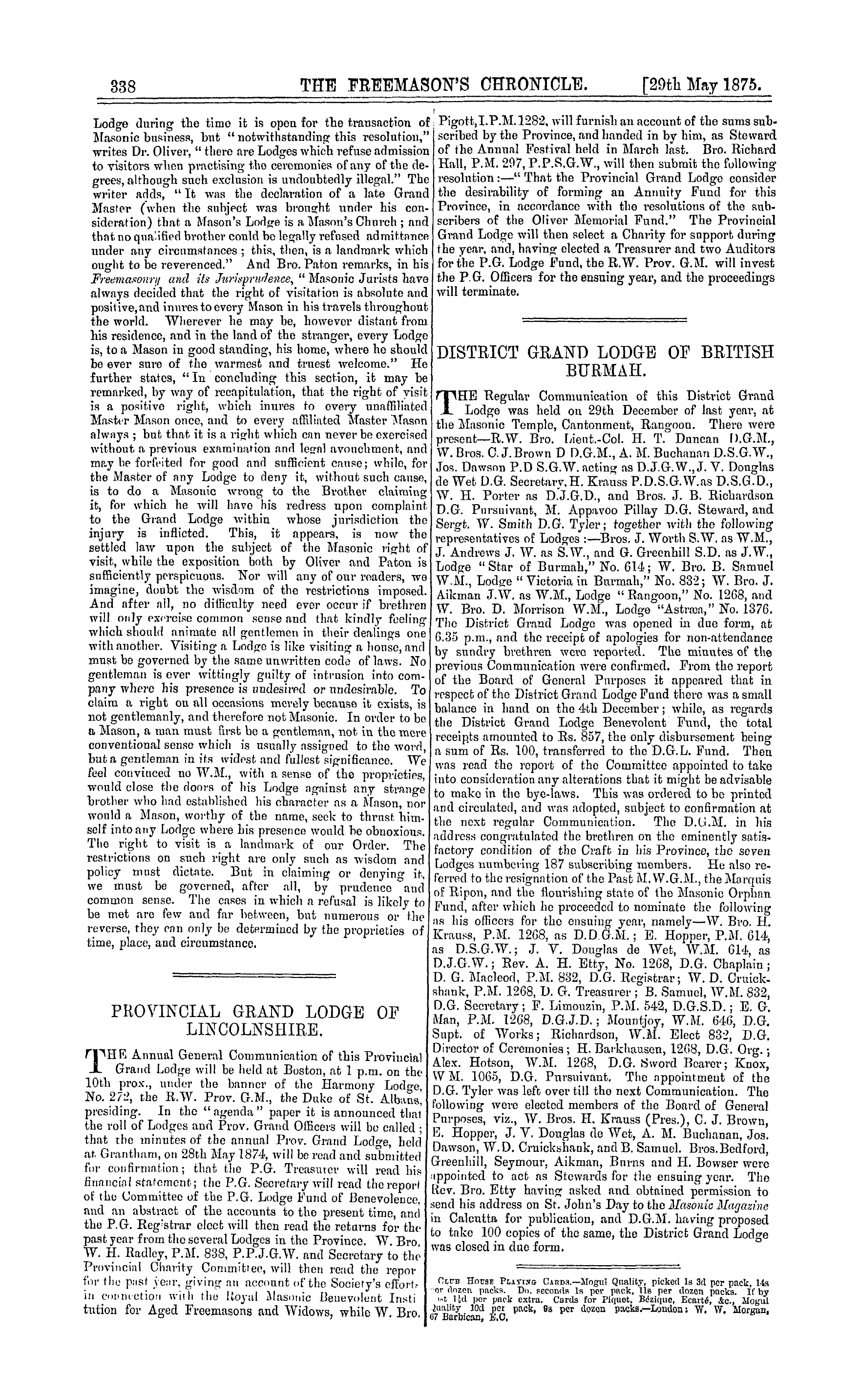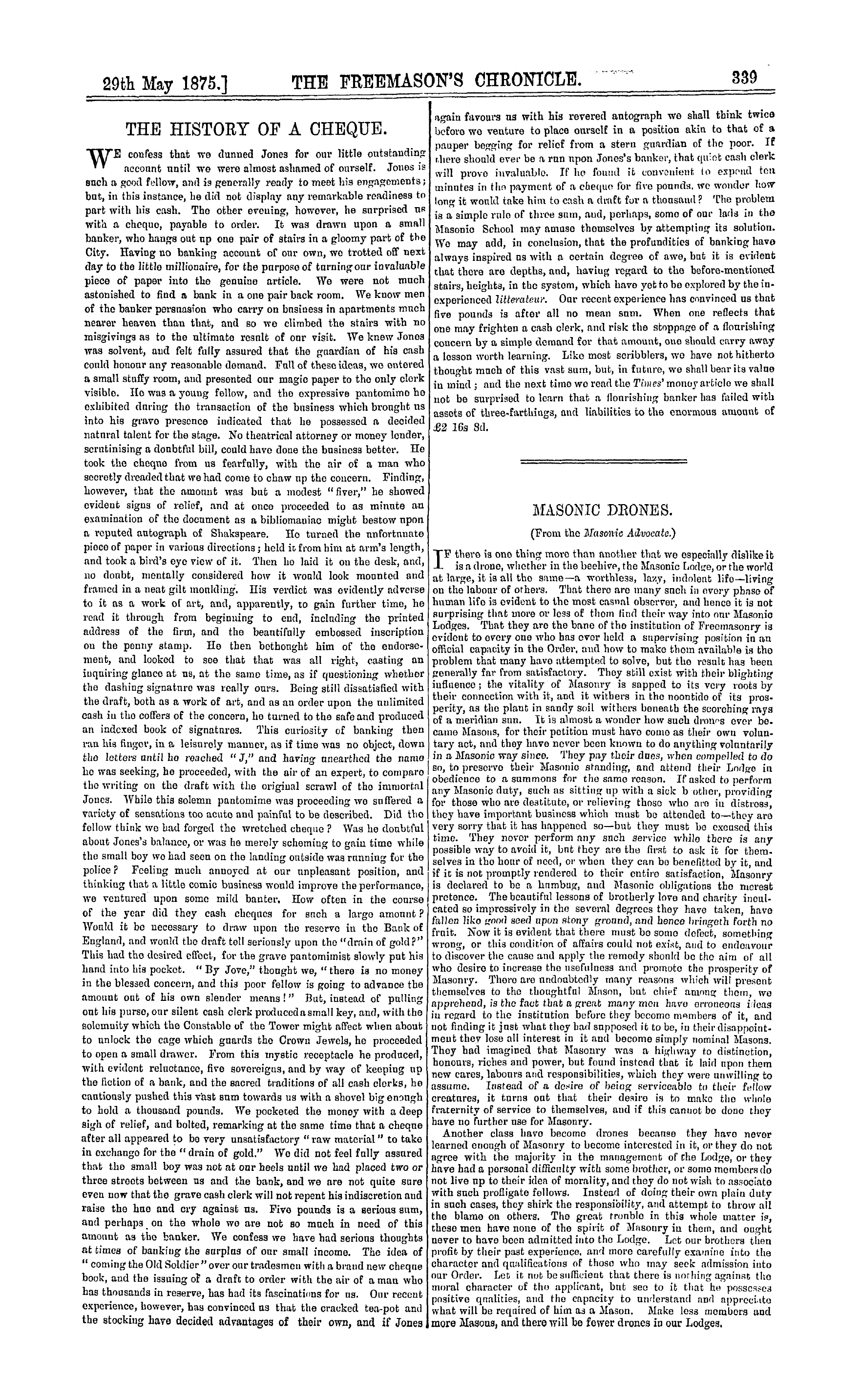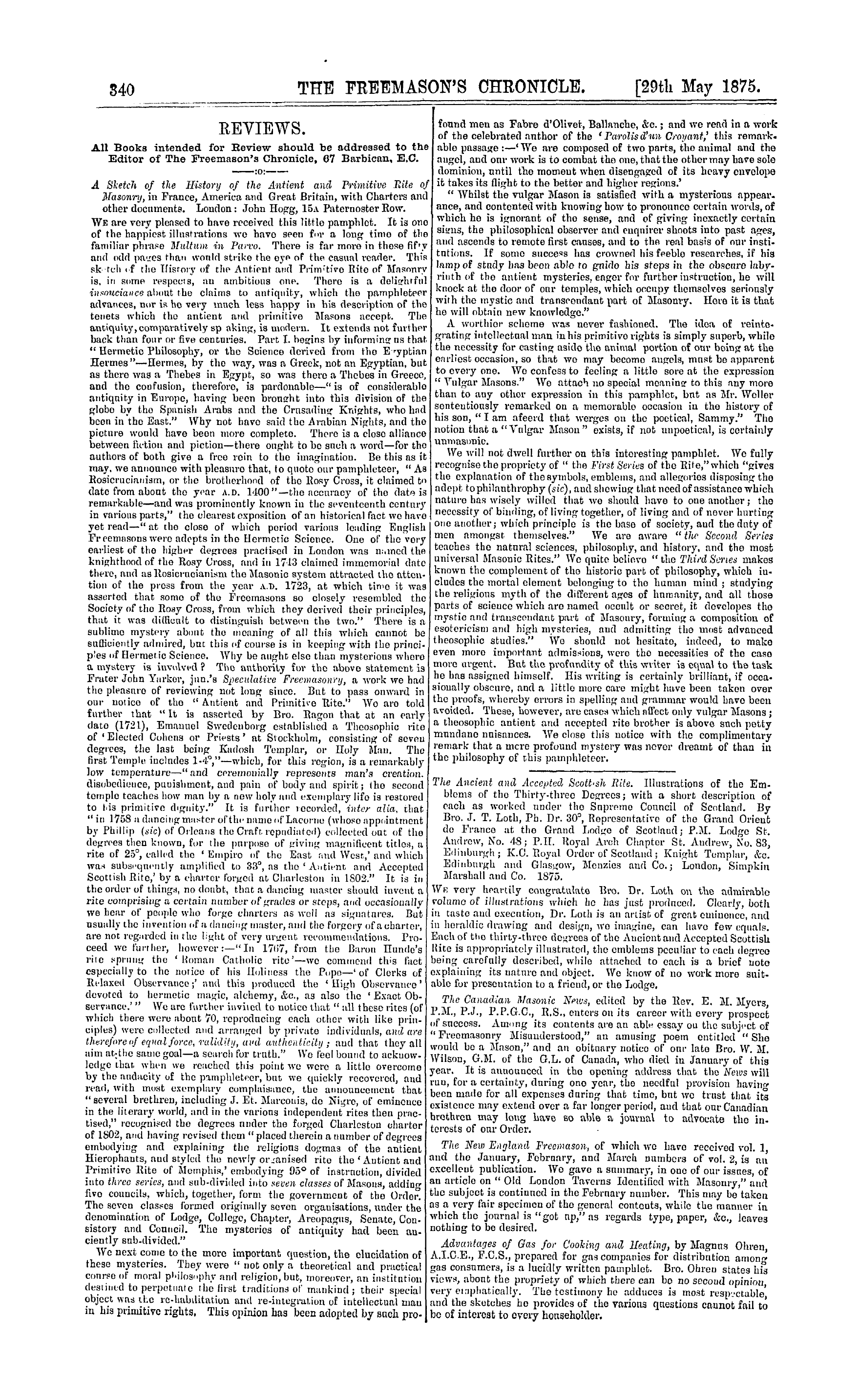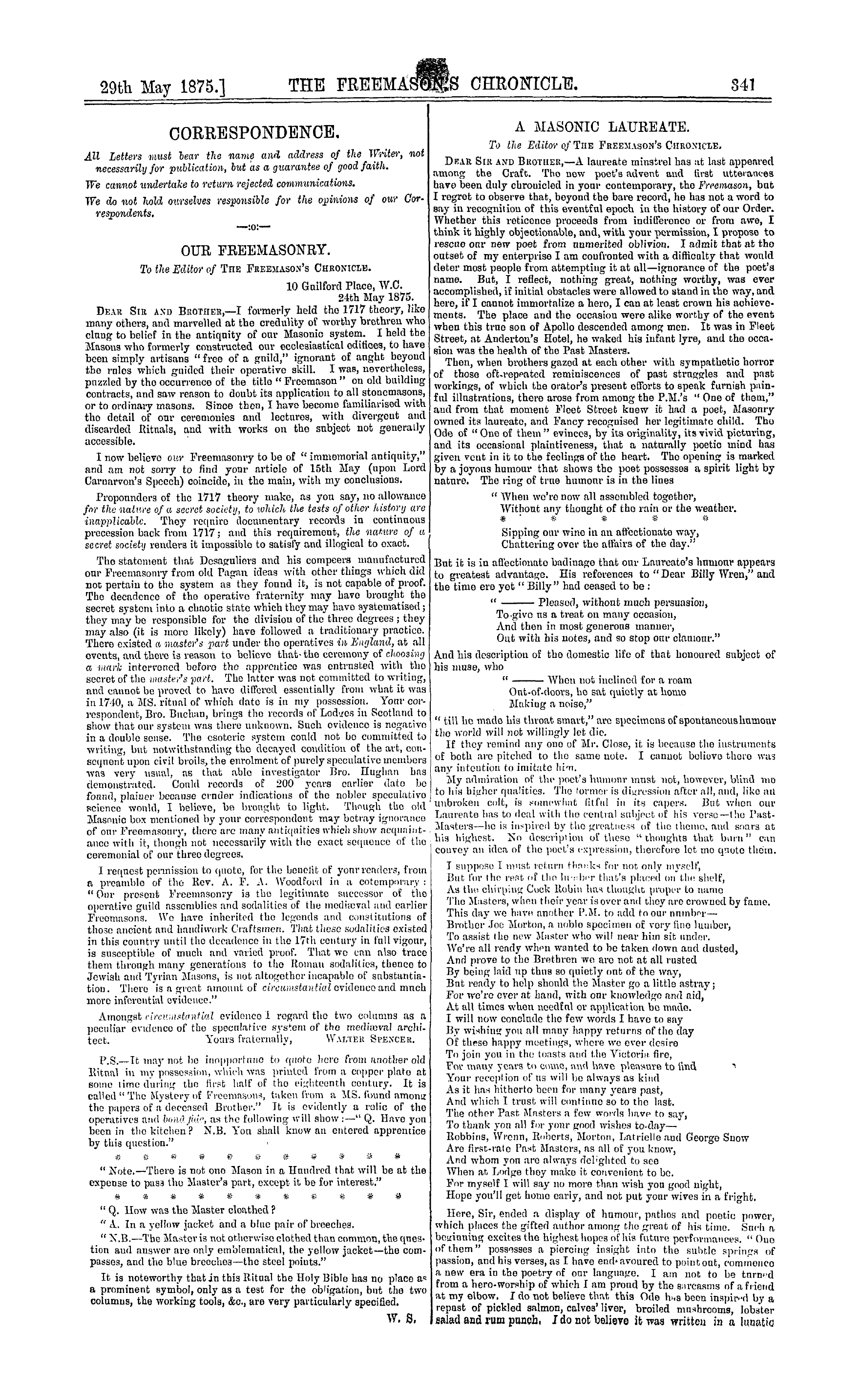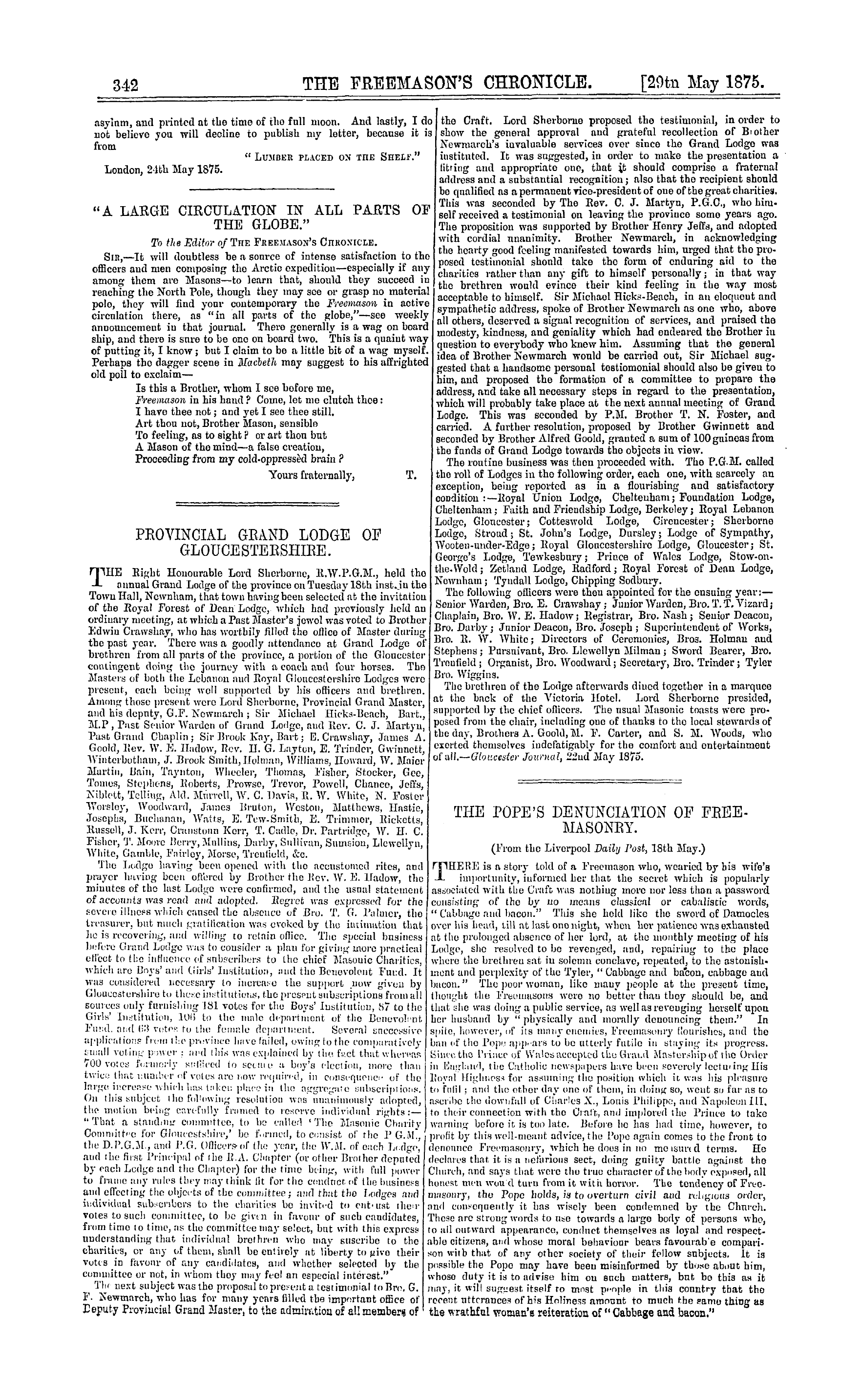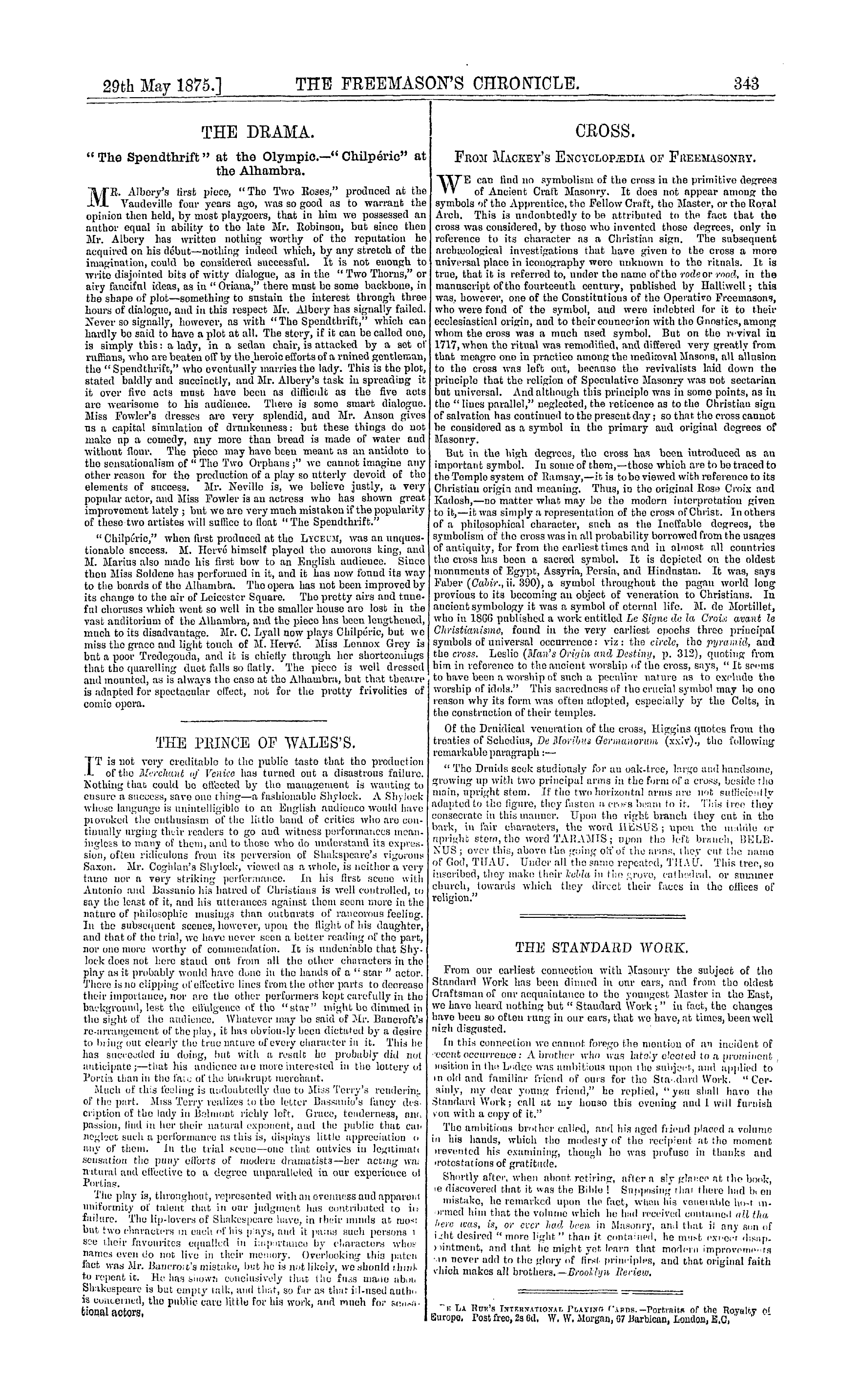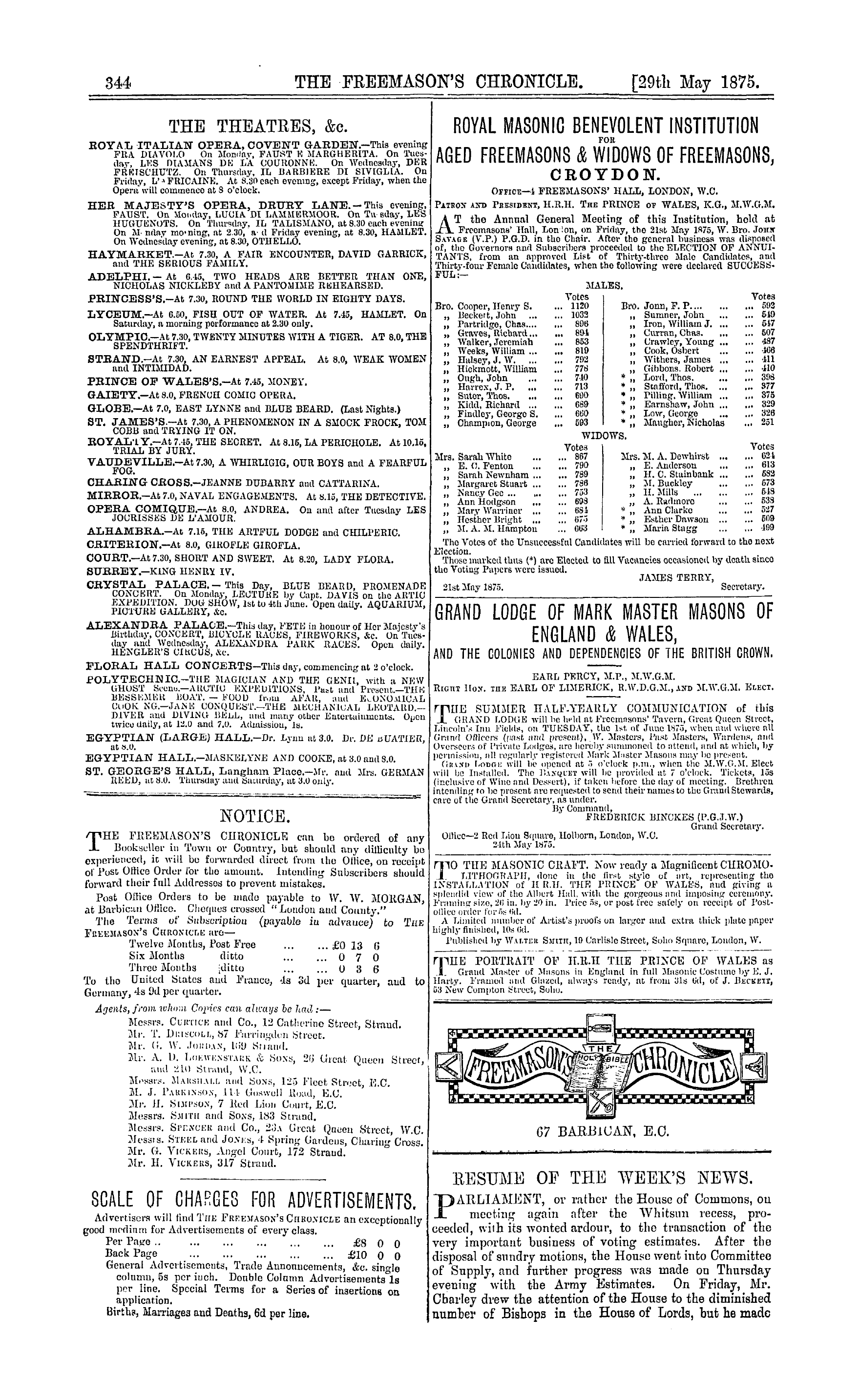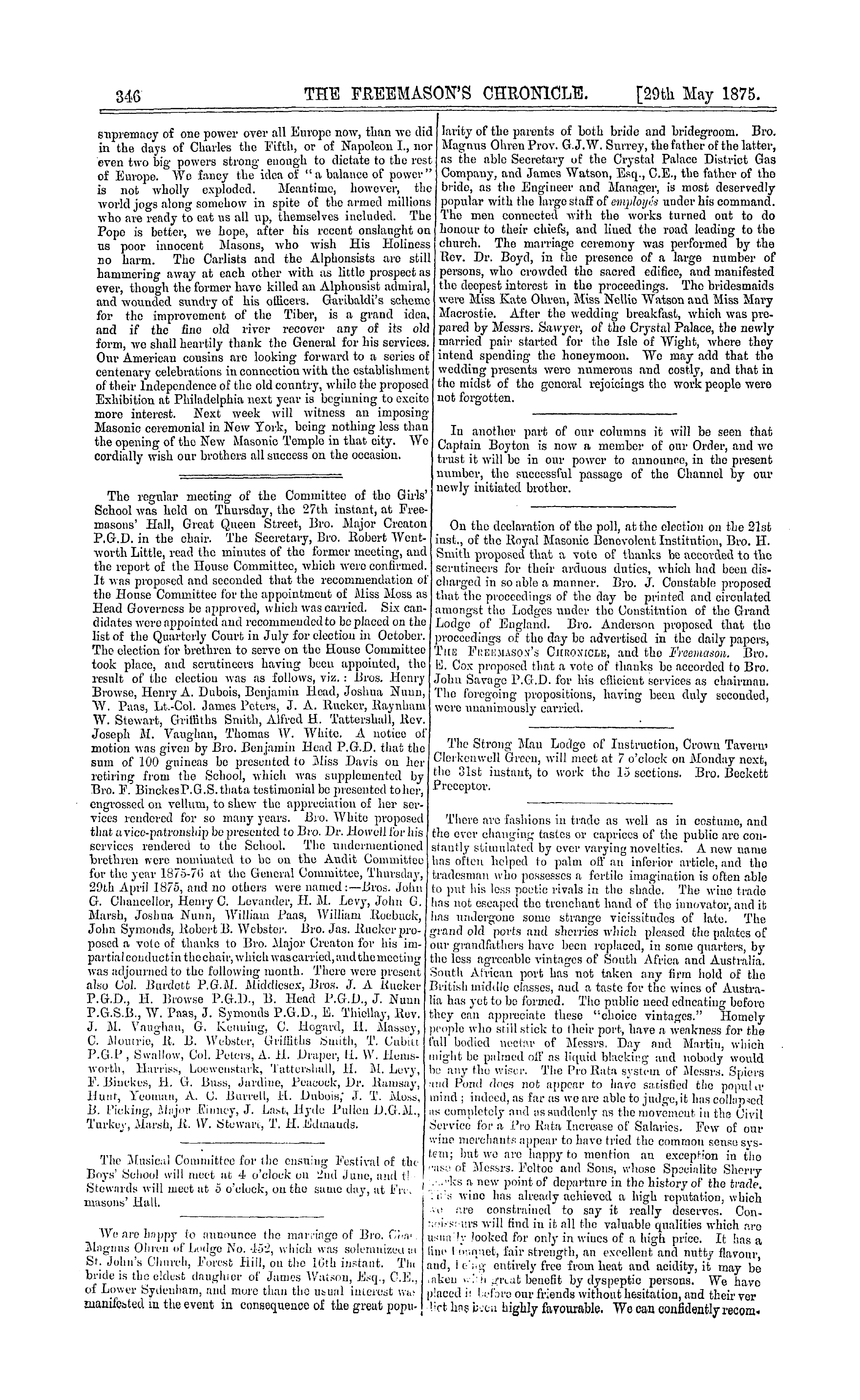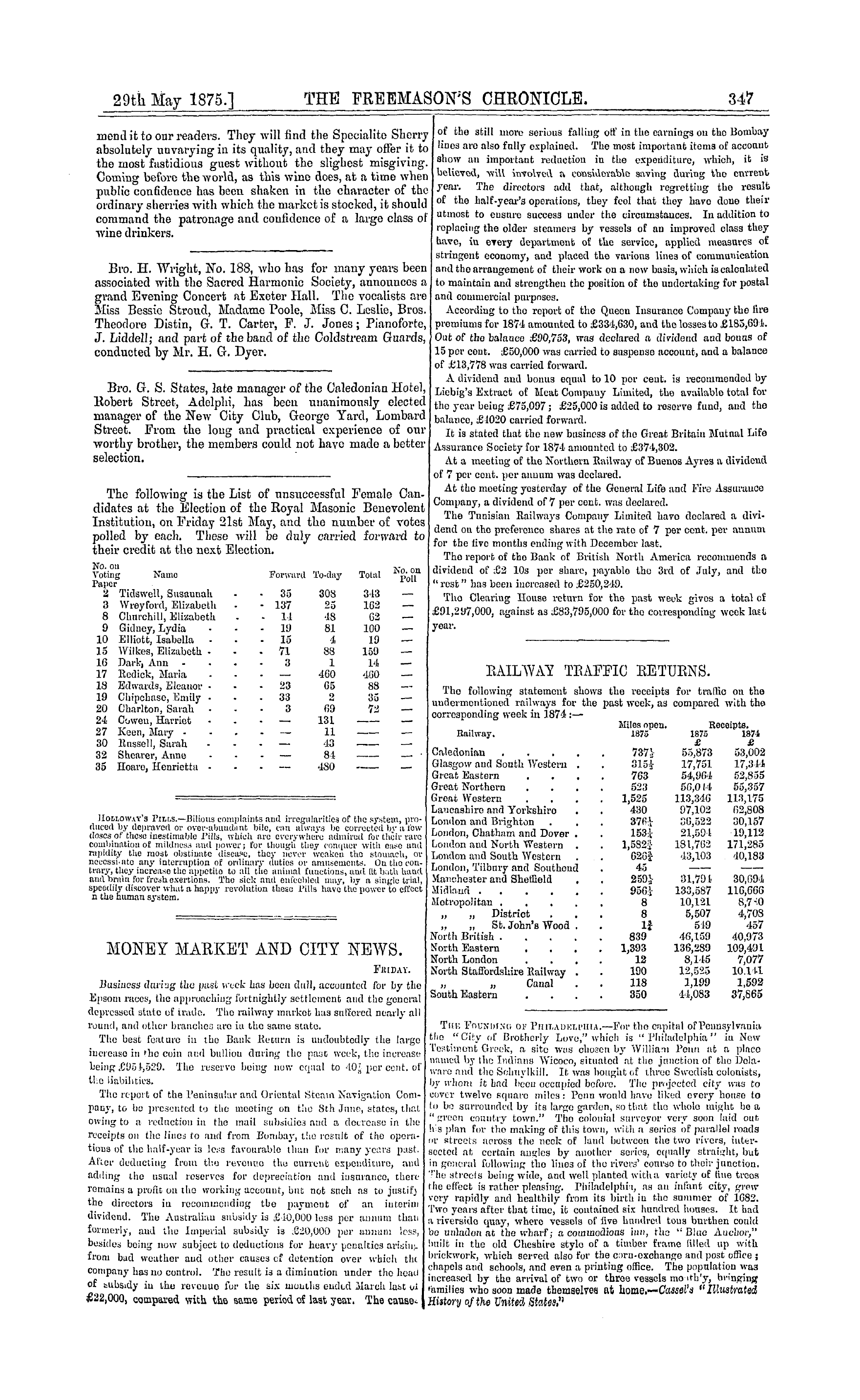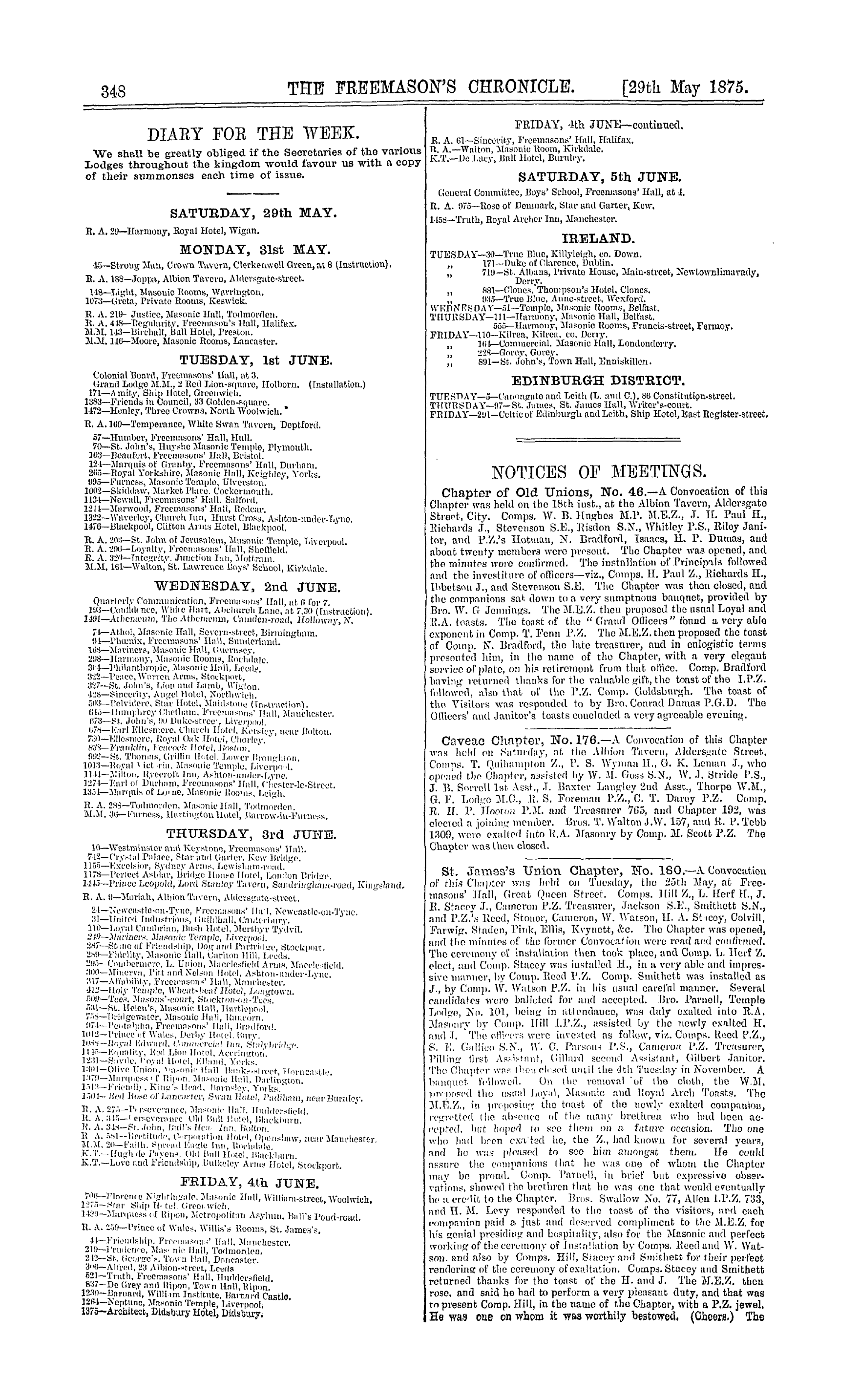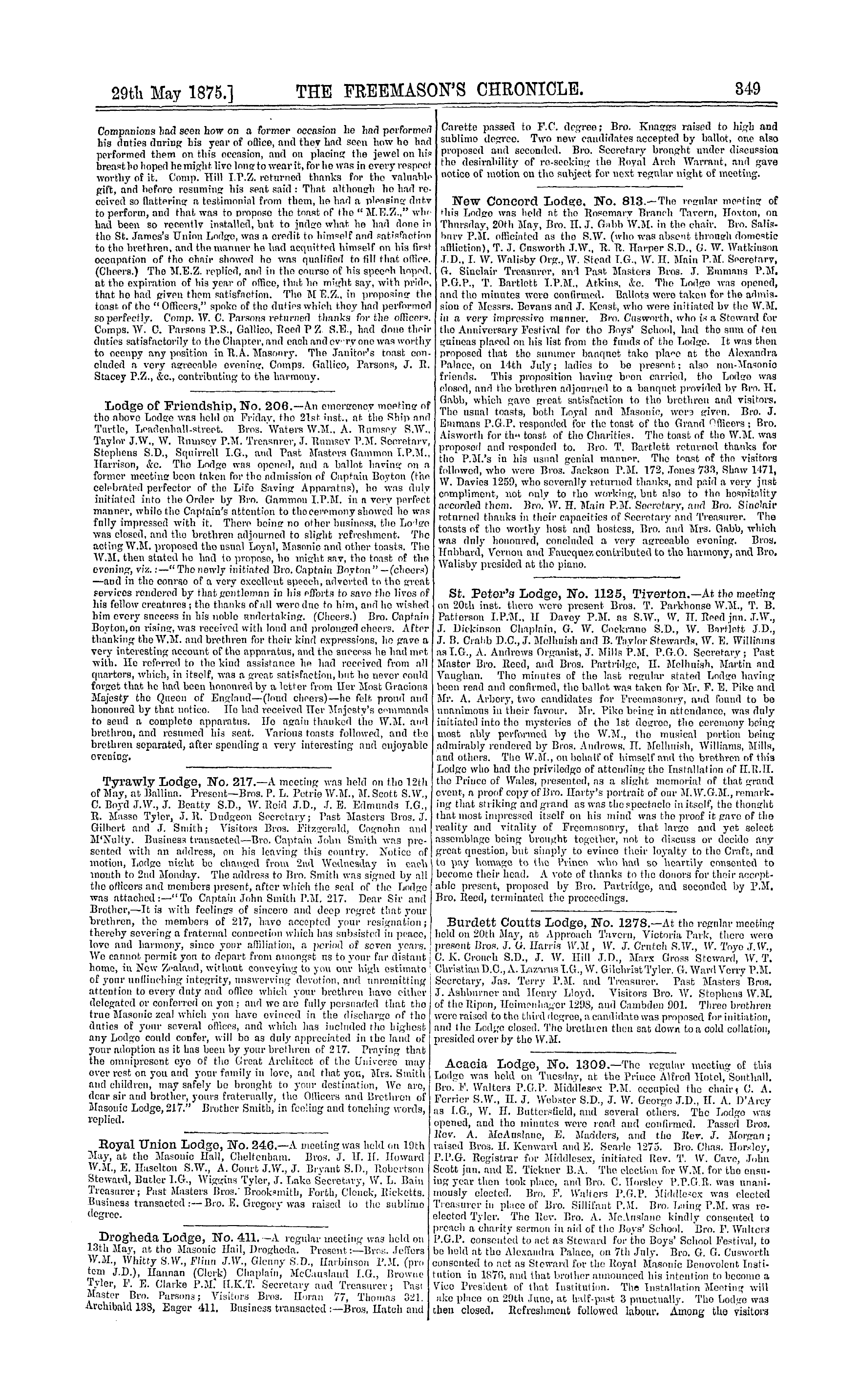Note: This text has been automatically extracted via Optical Character Recognition (OCR) software.
Reviews.
REVIEWS .
All Books intended for Eeview should be addressed to the Editor of The Freemason ' s Chronicle , 67 Barbican , E . G . A Sketclt of tlie History of the Antient and Primitive Bite of Masonry , in France , America and Great Britain , with Charters and other documents . London : John Hogg , 15 A Paternoster Bow . WE are very pleased to have received this little pamphlet . It is ono
of the happiest illustrations wo havo seen fur a long timo of the familiar phrase Multiim in Parvo . There is far more in those fif'y and odd paws than would strike the eyp of the casual reader . This sk tch of the History of the Antient and Primitive Rite of Masonry is , in some respects , an ambitious one . There is a delightful insouciance about the claims to antiquity , which the pamphleteer
advances , nor is ho very much less happy in his description of tho tenets which tho antient and primitive Masons accept . The antiquity , comparatively sp aking , is modern . It extends not further back than four or five centuries . Part I . bogins by informing us that " Hermetic Philosophy , or tho Science derived from tho Egyptian Hermes" —Hermes , by the way , was a Greek , not an Egyptian , but
as there was a Thebes in Egypt , so was there a Thebes in Greece , and the confusion , therefore , is pardonable— "is of considerable antiquity in Europe , having been brought into this division of the globe by tho Spanish Arabs and the Crusading Knights , who had been in tho East . " Why not havo said the Arabian Nights , and the picture would have been more complete . There is a closo alliance
between fiction and piction—there ought to be snob a word—for the authors of both give a free rein to the imagination . Be this as it may , we announce with pleasnro that , to quoto our pamphleteer , " As Rosicrucianisrn , or the brotherhood of tho Rosy Cross , it claimed t « date from about tho year A . D . 1400 "—the accuracy of the date is remarkable—and was prominontly known in tho seventeenth century
in various parts , the clearest exposition of an historical fact we havo yet read—" at the close of which poriod various leading English Freemasons were adepts in the Hermetic Science . One of the very earliest of the higher degrees practised in London was named the knighthood of the Rosy Cross , and in 1713 claimed immemorial date there , and as Rosicrucianisrn tho Masonic system attracted tho
attention of the press from the year A . D . 1723 , at which time it was asserted that somo of the Freemasons so closely resembled the Society of the Rosy Cross , from which they derived their principles , that it was difficult to distinguish between the two . " There is a sublime mystery about the moaning of all this which cannot be sufficiently admired , but this of course is in keeping with tho
principles of Hermetic Science . Wh y be aught else than mysterious where a mystery is involved ? Tho authority for tho above statement is Frater John Yarkor , jun . ' s Speculative Freemasonry , a work we had the pleasnro of reviewing not long since . But to pass onward in our noiico of tho " Antient and Primitive Rite . " Wo aro told further that " It is asserted by Bro . Ragon that at an early
dato ( 1721 ) , Emanuel Swedenborg established a Theosophic rite of 'Elected Cohens or Priests' at Stockholm , consisting of seven degrees , the last being Kadosh Templar , or Holy Man . The first Temple includes 1-4 ° , "—which , for this region , is a remarkably low temperature— " and ceremonially represents man's creation , disobedience , puuishment , and pain of body and spirit ; the secoud
temple teaches how man by a new holy and exemplary lifo is restored to his primitive dignity . " It is further recorded , inter alia , that "in 1758 a dancing master of the name of Laconic ( whoso appointment by Phillip ( sic ) of Orleans the Craft , ropndiatcd ) collected out of the degrees then known , for the purpose of giving magnificent titles , a rite of 25 ° , called the 'Empire of tho East and West , ' and which
was subsequently amplified to 33 , as the ' Antient and Accepted Scottish Rite , ' by a charter forged at Charleston in 1 S 02 . " It is in the order of things , no doubt , that a dancing master should invent a rite comprising a certain number of grades or steps , and occasionally we hear of people who forge charters as well as signatures . But usually the invention of a dancing master , and the forgery of a charter ,
are not regarded in tho light of very urgent recommendations . Proceed we further , however : — "In 17 li 7 , from the Baron Hundo ' s rite sprung the ' Uoman Catholic rite '—we commend this fact especially to the notice of his Holiness the Pope—' of Clerks of Relaxed Observance ; ' and this produced the ' High Observance ' devoted to hermetic magic , alchemy , & c , as also the ' Exact
Observance . ' ' We are further iisvhcd to notice that " all these rites ( of which there were about 70 , reproducing each other with like principles ) were collected and arranged by private individuals , and are therefore of equal force , validity , avd authenticity ; and that they all aim at thc same goal—a search for truth . " We feel bound to acknowledge that when we reached this point we were a little overcome
by the audacity of tho pamphleteer , but we quickly recovered , and read , with most exemplary complaisance , the announcement that " several brethren , including J . Et . Marcouis , do Nigro , of eminence in the literary world , and in tho various independent rites then practised , " recognised the degrees under the forged Charleston charter of 1 S 02 , and having revised them " placed therein a number of degrees
embodying and explaining the religions dogmas of the antient Hierophants , and styled tho nowty organised rito the'Antient and Primitive Rite of Memphis , ' embodying 95 ° of instruction , divided into three series , and sub-divided into seven classes of Masons , adding fivo councils , which , together , form the government of the Order ! The seven classes formed originally seven organisations , under the denomination of Lodge , College , Chapter , Areopagus , Senate ,
Consistory and Council . The mysteries of antiquity had been anciently sub-divided . " We next come to the more important question , the elucidation of these mysteries . They were " not only a theoretical and practical course of moral philosophy and religion , but , moreover , an institution destined to perpetuate the first traditions of mankind ; their special object was the re-habilitation and re-iutegration of intellectual man in his primitive rights , This opinion has been adopted by such pro-
Reviews.
found men as Fabre d'Olivet , Ballauche , & c . ; and we read in a work of the celebrated anthor of the ' Parolis d ' un Cray ant , ' this remark , able passage : — ' We are composed of two parts , tho animal and the angel , and our work is to combat the one , that the other may have sole dominion , until the moment when disengaged of its heavy envelope it takes its flight to tho better and higher regions . '
" Whilst the vulgar Mason is satisfied with a mysterious appearance , and oontented with knowing how to pronounce certain words , of which he is ignorant of tho sense , and of giving inexactly certain signs , the philosophical observer and enqnirer shoots into past ages , and ascends to remote first causes , and to the real basis of our institutions . If somo success has crowned his feeble researches , if hi 3
lamp of stndy has beon ablo to gnido his steps in the obsenre labyrinth of the antient mysteries , eager for further instruction , he will knock at the door of our temples , which occupy themselves seriously with the mystic and transeondant part of Masonry . Here it is that ho will obtain new knowledge . " A worthier scheme was never fashioned . The idea of
reintngrating intellectual man mhis primitivo rights is simply superb , while the necessity for casting asido tho animal portion of our being at the earliest occasion , so that wo may becomo angels , must be apparent to every one . Wo confess to feeling a little sore at the expression " Vulgar Masons . " We attach no special moaning to this any more
than to any other expression in this pamphlet , but as Mr . Woller senteutionsly remarked on a memorable occasion in the history of his son , " I am afeerd that werges on tho poetical , Sammy . " The notion that a "Vulgar Mason" exists , if not unpoetical , is certainly unmasonic .
We will not dwell further on this interesting pamphlet . Wo fully recognise the propriety of " the First Series of the Rite , " which " gives the explanation of the symbols , emblems , and allegories disposing tho adept tophilanthrophy ( sic ) , and shewing that need of assistance which naturo has wisely willed that wo should have to one another ; the necessity of binding , of living together , of living and of never hurting
one another ; which principle is the base of society , aud the duty of men amongst themselves . " We are aware "the Second Series teaches the natural sciences , philosophy , and history , and the most universal Masonic Rites . " Wo quite bolievo "the Third Series makes known the complement of tho historic part of philosophy , which includes the mortal element belonging to tho human mind ; studying
the religious myth of the different ages of humanity , and all those parts of scieuco which aro named occult or secret , it dovclopes tho mystic and transeondant part of Masonry , forming a composition of esotericism and high mysteries , aud admitting the most advanced theosophic studies . " We should not hesitate , indeed , to make
even more important admissions , were tho necessities of tho caso more urgent . But the profundity of this writer is equal to the task he has assigned himself . His writing is certainly brilliant , if occasionally obscure , and a little more care might have been taken over the proofs , whereby errors in spelling and grammar would havo been
avoided . These , however , are cases which affect only vulgar Masons ; a theosophic antient and accepted rite brother is above such petty mundane nuisances . We close this notice with the complimentary remark that a mere profound mystery was never dreamt of than in tho philosophy of this pamphleteer .
The Ancient and Accepted Scott-sh Rite . Illustrations of the Emblems of tho Thirty-threo Degrees ; with a short description of each as worked under tho Supremo Council of Scotland . By Bro . J . T . Loth , Ph . Dr . 30 ° , Representative of tho Grand Orient
do Franco at the Grand Lodge of Scotland ; P . M . Lodge St . Andrew , No . 48 ; P . H . Royal Arch Chapter St . Andrew , No . 83 , Edinburgh ; K . C . Royal Order of Scotland ; Knight Templar , Sec Edinburgh and Glasgow , Menzies aud Co . ; London , Simpkin Marshall and Co . 1875 .
WK very heartily congratulate Bro . Dr . Loth on the admirable volume of illustrations which ho has just produced . Clearly , both in tasto aud execution , Dr . Loth is an artist of great eminence , and in heraldic drawing and design , wo imagine , can have few equals .
Each of tlie thirty-three degrees of the Auciontand Accepted Scottish Kite is appropriately illustrated , the emblems peculiar to each degree being carefully described , while attached to each is a brief note explaining its nature and object . Wo know of no work more suitable for presentation to a friend , or the Lodge ,
The Canadian Masonic News , edited by the Rev . E . M . Myers , P . M ., P . J ., P . P . G . C ., R . S ., enters on its career with every prospect of success . Among its contents are an able essay ou the subject of " Freemasonry Misunderstood , " an amusing poem entitled " She would be a Mason , " and an obituary notico of our late Bro . W . M . Wilson , G . M . of the G . L . of Canada , who died in January of this
year . It is announced in tho opening address that the News will ruu , for a certainty , during ono year , tho needful provision having been made for all expenses during that timo , but we trust that its existence may extend over a far longer period , aud that our Canadian brethren may long have so able a journal to advocate the inforests of our Order .
The New England Freemason , of which we have received vol . 1 and tho January , February , and March numbers of vol . 2 , is an excellent publication . Wo gave a summary , in one of our issues , of an article on " Old London Taverns Identified with Masonry , " and the subject is continued in the February number . This may be taken as a very fair specimen of tho general contents , while the manner in which the journal is "got up , " as regards type , paper , & c , leaves nothing to be desired .
Advantages of Gas for Cooling and Heating , by Magnus Ohren , A . I . C . E ., F . C . S ., prepared for gas companies for distribution anions gas consumers , is a lucidly written pamphlet . Bro . Ohren states his views , about the propriety of which there can bo no secoud opinion , very emphatically . The testimony he adduces is most resp-ctable and the sketches he provides of the various questions cannot fail to be of interost to every householder .
Note: This text has been automatically extracted via Optical Character Recognition (OCR) software.
Reviews.
REVIEWS .
All Books intended for Eeview should be addressed to the Editor of The Freemason ' s Chronicle , 67 Barbican , E . G . A Sketclt of tlie History of the Antient and Primitive Bite of Masonry , in France , America and Great Britain , with Charters and other documents . London : John Hogg , 15 A Paternoster Bow . WE are very pleased to have received this little pamphlet . It is ono
of the happiest illustrations wo havo seen fur a long timo of the familiar phrase Multiim in Parvo . There is far more in those fif'y and odd paws than would strike the eyp of the casual reader . This sk tch of the History of the Antient and Primitive Rite of Masonry is , in some respects , an ambitious one . There is a delightful insouciance about the claims to antiquity , which the pamphleteer
advances , nor is ho very much less happy in his description of tho tenets which tho antient and primitive Masons accept . The antiquity , comparatively sp aking , is modern . It extends not further back than four or five centuries . Part I . bogins by informing us that " Hermetic Philosophy , or tho Science derived from tho Egyptian Hermes" —Hermes , by the way , was a Greek , not an Egyptian , but
as there was a Thebes in Egypt , so was there a Thebes in Greece , and the confusion , therefore , is pardonable— "is of considerable antiquity in Europe , having been brought into this division of the globe by tho Spanish Arabs and the Crusading Knights , who had been in tho East . " Why not havo said the Arabian Nights , and the picture would have been more complete . There is a closo alliance
between fiction and piction—there ought to be snob a word—for the authors of both give a free rein to the imagination . Be this as it may , we announce with pleasnro that , to quoto our pamphleteer , " As Rosicrucianisrn , or the brotherhood of tho Rosy Cross , it claimed t « date from about tho year A . D . 1400 "—the accuracy of the date is remarkable—and was prominontly known in tho seventeenth century
in various parts , the clearest exposition of an historical fact we havo yet read—" at the close of which poriod various leading English Freemasons were adepts in the Hermetic Science . One of the very earliest of the higher degrees practised in London was named the knighthood of the Rosy Cross , and in 1713 claimed immemorial date there , and as Rosicrucianisrn tho Masonic system attracted tho
attention of the press from the year A . D . 1723 , at which time it was asserted that somo of the Freemasons so closely resembled the Society of the Rosy Cross , from which they derived their principles , that it was difficult to distinguish between the two . " There is a sublime mystery about the moaning of all this which cannot be sufficiently admired , but this of course is in keeping with tho
principles of Hermetic Science . Wh y be aught else than mysterious where a mystery is involved ? Tho authority for tho above statement is Frater John Yarkor , jun . ' s Speculative Freemasonry , a work we had the pleasnro of reviewing not long since . But to pass onward in our noiico of tho " Antient and Primitive Rite . " Wo aro told further that " It is asserted by Bro . Ragon that at an early
dato ( 1721 ) , Emanuel Swedenborg established a Theosophic rite of 'Elected Cohens or Priests' at Stockholm , consisting of seven degrees , the last being Kadosh Templar , or Holy Man . The first Temple includes 1-4 ° , "—which , for this region , is a remarkably low temperature— " and ceremonially represents man's creation , disobedience , puuishment , and pain of body and spirit ; the secoud
temple teaches how man by a new holy and exemplary lifo is restored to his primitive dignity . " It is further recorded , inter alia , that "in 1758 a dancing master of the name of Laconic ( whoso appointment by Phillip ( sic ) of Orleans the Craft , ropndiatcd ) collected out of the degrees then known , for the purpose of giving magnificent titles , a rite of 25 ° , called the 'Empire of tho East and West , ' and which
was subsequently amplified to 33 , as the ' Antient and Accepted Scottish Rite , ' by a charter forged at Charleston in 1 S 02 . " It is in the order of things , no doubt , that a dancing master should invent a rite comprising a certain number of grades or steps , and occasionally we hear of people who forge charters as well as signatures . But usually the invention of a dancing master , and the forgery of a charter ,
are not regarded in tho light of very urgent recommendations . Proceed we further , however : — "In 17 li 7 , from the Baron Hundo ' s rite sprung the ' Uoman Catholic rite '—we commend this fact especially to the notice of his Holiness the Pope—' of Clerks of Relaxed Observance ; ' and this produced the ' High Observance ' devoted to hermetic magic , alchemy , & c , as also the ' Exact
Observance . ' ' We are further iisvhcd to notice that " all these rites ( of which there were about 70 , reproducing each other with like principles ) were collected and arranged by private individuals , and are therefore of equal force , validity , avd authenticity ; and that they all aim at thc same goal—a search for truth . " We feel bound to acknowledge that when we reached this point we were a little overcome
by the audacity of tho pamphleteer , but we quickly recovered , and read , with most exemplary complaisance , the announcement that " several brethren , including J . Et . Marcouis , do Nigro , of eminence in the literary world , and in tho various independent rites then practised , " recognised the degrees under the forged Charleston charter of 1 S 02 , and having revised them " placed therein a number of degrees
embodying and explaining the religions dogmas of the antient Hierophants , and styled tho nowty organised rito the'Antient and Primitive Rite of Memphis , ' embodying 95 ° of instruction , divided into three series , and sub-divided into seven classes of Masons , adding fivo councils , which , together , form the government of the Order ! The seven classes formed originally seven organisations , under the denomination of Lodge , College , Chapter , Areopagus , Senate ,
Consistory and Council . The mysteries of antiquity had been anciently sub-divided . " We next come to the more important question , the elucidation of these mysteries . They were " not only a theoretical and practical course of moral philosophy and religion , but , moreover , an institution destined to perpetuate the first traditions of mankind ; their special object was the re-habilitation and re-iutegration of intellectual man in his primitive rights , This opinion has been adopted by such pro-
Reviews.
found men as Fabre d'Olivet , Ballauche , & c . ; and we read in a work of the celebrated anthor of the ' Parolis d ' un Cray ant , ' this remark , able passage : — ' We are composed of two parts , tho animal and the angel , and our work is to combat the one , that the other may have sole dominion , until the moment when disengaged of its heavy envelope it takes its flight to tho better and higher regions . '
" Whilst the vulgar Mason is satisfied with a mysterious appearance , and oontented with knowing how to pronounce certain words , of which he is ignorant of tho sense , and of giving inexactly certain signs , the philosophical observer and enqnirer shoots into past ages , and ascends to remote first causes , and to the real basis of our institutions . If somo success has crowned his feeble researches , if hi 3
lamp of stndy has beon ablo to gnido his steps in the obsenre labyrinth of the antient mysteries , eager for further instruction , he will knock at the door of our temples , which occupy themselves seriously with the mystic and transeondant part of Masonry . Here it is that ho will obtain new knowledge . " A worthier scheme was never fashioned . The idea of
reintngrating intellectual man mhis primitivo rights is simply superb , while the necessity for casting asido tho animal portion of our being at the earliest occasion , so that wo may becomo angels , must be apparent to every one . Wo confess to feeling a little sore at the expression " Vulgar Masons . " We attach no special moaning to this any more
than to any other expression in this pamphlet , but as Mr . Woller senteutionsly remarked on a memorable occasion in the history of his son , " I am afeerd that werges on tho poetical , Sammy . " The notion that a "Vulgar Mason" exists , if not unpoetical , is certainly unmasonic .
We will not dwell further on this interesting pamphlet . Wo fully recognise the propriety of " the First Series of the Rite , " which " gives the explanation of the symbols , emblems , and allegories disposing tho adept tophilanthrophy ( sic ) , and shewing that need of assistance which naturo has wisely willed that wo should have to one another ; the necessity of binding , of living together , of living and of never hurting
one another ; which principle is the base of society , aud the duty of men amongst themselves . " We are aware "the Second Series teaches the natural sciences , philosophy , and history , and the most universal Masonic Rites . " Wo quite bolievo "the Third Series makes known the complement of tho historic part of philosophy , which includes the mortal element belonging to tho human mind ; studying
the religious myth of the different ages of humanity , and all those parts of scieuco which aro named occult or secret , it dovclopes tho mystic and transeondant part of Masonry , forming a composition of esotericism and high mysteries , aud admitting the most advanced theosophic studies . " We should not hesitate , indeed , to make
even more important admissions , were tho necessities of tho caso more urgent . But the profundity of this writer is equal to the task he has assigned himself . His writing is certainly brilliant , if occasionally obscure , and a little more care might have been taken over the proofs , whereby errors in spelling and grammar would havo been
avoided . These , however , are cases which affect only vulgar Masons ; a theosophic antient and accepted rite brother is above such petty mundane nuisances . We close this notice with the complimentary remark that a mere profound mystery was never dreamt of than in tho philosophy of this pamphleteer .
The Ancient and Accepted Scott-sh Rite . Illustrations of the Emblems of tho Thirty-threo Degrees ; with a short description of each as worked under tho Supremo Council of Scotland . By Bro . J . T . Loth , Ph . Dr . 30 ° , Representative of tho Grand Orient
do Franco at the Grand Lodge of Scotland ; P . M . Lodge St . Andrew , No . 48 ; P . H . Royal Arch Chapter St . Andrew , No . 83 , Edinburgh ; K . C . Royal Order of Scotland ; Knight Templar , Sec Edinburgh and Glasgow , Menzies aud Co . ; London , Simpkin Marshall and Co . 1875 .
WK very heartily congratulate Bro . Dr . Loth on the admirable volume of illustrations which ho has just produced . Clearly , both in tasto aud execution , Dr . Loth is an artist of great eminence , and in heraldic drawing and design , wo imagine , can have few equals .
Each of tlie thirty-three degrees of the Auciontand Accepted Scottish Kite is appropriately illustrated , the emblems peculiar to each degree being carefully described , while attached to each is a brief note explaining its nature and object . Wo know of no work more suitable for presentation to a friend , or the Lodge ,
The Canadian Masonic News , edited by the Rev . E . M . Myers , P . M ., P . J ., P . P . G . C ., R . S ., enters on its career with every prospect of success . Among its contents are an able essay ou the subject of " Freemasonry Misunderstood , " an amusing poem entitled " She would be a Mason , " and an obituary notico of our late Bro . W . M . Wilson , G . M . of the G . L . of Canada , who died in January of this
year . It is announced in tho opening address that the News will ruu , for a certainty , during ono year , tho needful provision having been made for all expenses during that timo , but we trust that its existence may extend over a far longer period , aud that our Canadian brethren may long have so able a journal to advocate the inforests of our Order .
The New England Freemason , of which we have received vol . 1 and tho January , February , and March numbers of vol . 2 , is an excellent publication . Wo gave a summary , in one of our issues , of an article on " Old London Taverns Identified with Masonry , " and the subject is continued in the February number . This may be taken as a very fair specimen of tho general contents , while the manner in which the journal is "got up , " as regards type , paper , & c , leaves nothing to be desired .
Advantages of Gas for Cooling and Heating , by Magnus Ohren , A . I . C . E ., F . C . S ., prepared for gas companies for distribution anions gas consumers , is a lucidly written pamphlet . Bro . Ohren states his views , about the propriety of which there can bo no secoud opinion , very emphatically . The testimony he adduces is most resp-ctable and the sketches he provides of the various questions cannot fail to be of interost to every householder .

